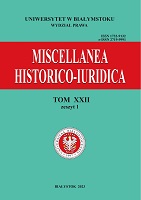Miejsca sakralne w służbie publicznej Wielkiego Księstwa Litewskiego XVII i XVIII w
Sacral Sites in the Public Service of the Grand Duchy of Lithuania in the 17th and 18th Centurie
Author(s): Oskar KaneckiSubject(s): Cultural history, Political history, Social history, 17th Century, 18th Century
Published by: Wydawnictwo Uniwersytetu w Białymstoku
Keywords: Grand Duchy of Lithuania; sacral sites; churches; monasteries; nobility regional councils (sejmik);
Summary/Abstract: The Polish-Lithuanian Commonwealth struggled with the problem of an insufficient number of facilities for the performance of state tasks, including buildings which could accommodate relatively numerous assemblies of nobility. This study addresses the dual role of the sacraled places sites in the Grand Duchy of Lithuania, which were often used for public purposes. Reading the universals, the documents of the regional councils (pol. sejmiks) – (especially parliamentary instructions) – and diary sources convinces us that they served, among other things, as places of debates for gatherings of the nobility bodies, schools, hospitals, archives, accommodation where monarchs sometimes stayed, or as places where tax revenues were kept and local officials took oaths. The frequency of this phenomenon is evidenced by the sums of money paid to monks on a cyclical basis, which not only covered the costs of operating the facilities which were made available to the nobility, but also had a compensatory function. Among other things, churches, including sacristies, monastic cells and refectories, chapels, and even cemeteries were used for public purposes (which, at least in some cases, raised doubts among the nobility). Attempts were made to convert the postformer Jesuit buildings into court houses, schools and detention centres.
Journal: Miscellanea Historico-Iuridica
- Issue Year: 22/2023
- Issue No: 1
- Page Range: 485-502
- Page Count: 18
- Language: Polish

